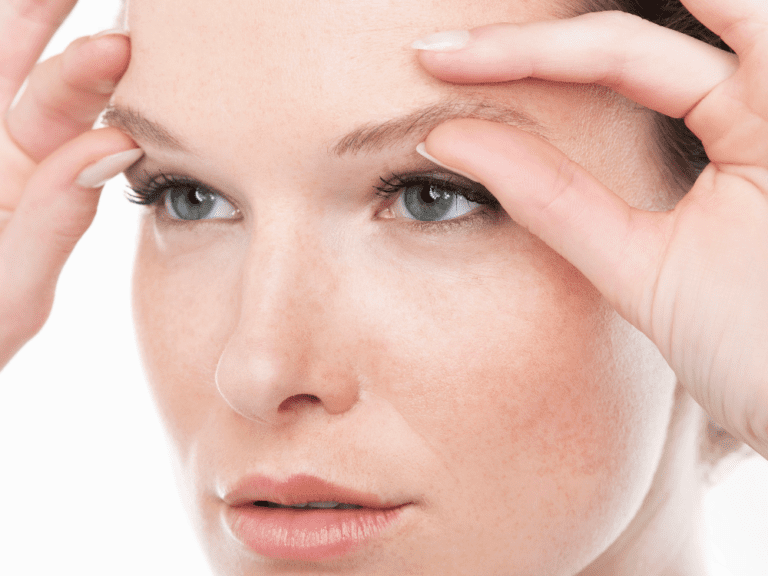The browlift just got a major update.
Refined in recent years, the “gliding browlift” is an evolution of the surgical technique that allows minimal incisions hidden in the hairline for an almost scar-free result. We spoke with McMurray, PA plastic surgeon Simona V. Pautler, MD to find out exactly how this lift works and how to know if a gliding browlift is right for us.
The Gliding Browlift
From a surgical perspective, the ‘sliding browlift’ is simple.
“A ‘brow lift’ is a simple surgical procedure to lift and/or change the shape of the eyebrows,” explains Dr. Pautler. “I say simple because it doesn’t involve special equipment like an endoscope or fancy instruments, and the fixation relies on the body’s natural healing mechanisms instead of screws, plates or absorbable glues.”
A quick procedure that can easily be combined with others, a “gliding browlift” involves separating the skin from the underlying muscle and then pulling the brow into place.
“With the skin separated from the underlying muscle of the forehead, the eyebrows can be ‘slid’ higher and, if desired, arched to change the shape,” says Dr. Pautler. “Pulling is done with small skin hooks that engage the skin to allow pulling from above. The brow and forehead skin are then fixed in place with about 20 percent overcorrection to allow for the inevitable sagging. The fixation is what is unique about this process.”
With the skin hooks still pulled over, the “fixation” is done with a suturing technique that prompts the skin to reattach to the muscle in a higher position.
“A suture is woven through the skin and muscle sandwich and gently compressed along multiple areas,” explains Dr. Pautler. “This continuous suture is known as a hemostatic mesh. The body forms an adhesion between the muscle and the skin, which allows the lift to be maintained. The stitches remain for three days and are removed in the doctor’s office.”
Once the stitches are out, your body does the rest.
What makes it different?
A traditional coronal browlift involves a large incision that goes from ear to ear, allowing the surgeon to lift the skin of the forehead and adjust the underlying muscles. The excess skin is then cut away and the incision is closed.
A major disadvantage, as you can imagine, is that the large incision leaves a large scar.
The idea with a “sliding browlift” is to make smaller incisions to reduce these scars.
“Through four small incisions made at the hairline, a rounded compact cannula, similar to a rounded knitting needle, is inserted just under the skin,” explains Dr. Pautler. “And with a gentle side view and forward and backward movement, the skin is separated from the underlying muscle.”
This procedure is significantly less invasive and although no skin is removed, it effectively smoothes horizontal forehead wrinkles. However, it doesn’t allow for any muscle removal (like the “eleven” line that causes muscles) that a classic browlift can. According to Dr. Pautler, it does best at lifting the tail of the brow, creating an arch, and lifting the entire brow. “
This type of lift can be customized to target just the lateral brow, just the middle brow, or the entire brow,” explains Dr. Pautler. “Forehead wrinkles look much smoother, except that vertical frown lines may still be there afterward.”
-
Before -


After
Am I a good candidate?
If you struggle with looking tired, have drooping brows or deep horizontal lines above the browbone, you may be a candidate for a ‘sliding browlift’.
“Patients who have a low brow or want an arched brow or have multiple horizontal wrinkles and want them smoother are all good candidates,” explains Dr. Pautler. “Smokers should stop for 6-8 weeks before surgery to minimize dermatitis, which is a potential complication.
“If your forehead concerns are greater than mild wrinkles, you may be a better candidate for a traditional facelift. Additionally, patients with very thick heavy brow tissue may not see optimal results with this technique.
Your hairline is another important factor to consider. More traditional browlift techniques can reduce the high hairline, which a “gliding browlift” cannot.
-


Before -


After
How is Recovery?
With the stitches coming out in just three days, the recovery process is mostly about waiting for the bruising to subside.
“There is always some swelling and bruising, as with any facial surgery,” says Dr. Pautler. “The recovery time is usually two to three weeks, mainly to allow the bruising to subside. Also, there is usually a small roll of gathered skin right at the hairline that needs to be shrunk.”
However, it will take a little longer for the numbness to completely subside.
“The whole forehead feels numb for about six to eight weeks, and that can be a little uncomfortable,” said Dr. Potler explains. “The numbness goes away, and as it does, there’s often itching, but that goes away too.”
Some patients may find their scars develop hyperpigmentation, which can be treated with brightening products.
“People with oily skin tones may develop post-inflammatory hyperpigmentation or suture marks, and post-surgical skin bleaching may need to be used,” says Dr. Pautler.


